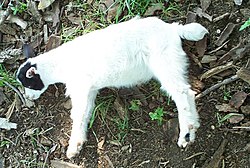Fainting goat
From Wikipedia, the free encyclopedia
A fainting goat is a breed of domestic goat whose muscles freeze for roughly 10 seconds when the goat is startled. Though painless, this generally results in the animal collapsing on its side. The characteristic is caused by a hereditary genetic disorder called myotonia congenita. When startled, younger goats will stiffen and fall over. Older goats learn to spread their legs or lean against something when startled, and often they continue to run about in an awkward, stiff-legged shuffle.
Slightly smaller than standard breeds of goat, fainting goats are generally 43 to 64 centimeters (17 to 25 in) tall and can weigh anywhere from 27 to 79 kilograms (50 to 175 lb). They have large, prominent eyes in high sockets. Their hair can be short or long, with certain individuals producing a great deal of cashmere during colder months. There appears to be no angora strain of the fainting goat. Common coat colors are black and white; however, most possible coat colors are found in this breed. Their life expectancy is 12 to 15 years.[1]
The origin of the fainting goat is peculiar. The goats appear to have arrived in Marshall County, Tennessee, in the early 1800s, courtesy of a reclusive farm worker named Jon Tinsley who was most likely from Nova Scotia. Before he left the area, he sold his goats — three does and a buck — to Dr. H.H. Mayberry, who bred them.
Fainting goats have many other names, including Myotonic Goats, Tennessee (Meat) Goats, Nervous Goats, Stiff-leg Goats, Wooden-leg Goats, and Tennessee Scare Goats. They are smaller and somewhat easier to care for and maintain than larger meat goat breeds, which makes the fainting goat desirable for smaller farms. They are also raised as pet or show animals as they can be friendly, intelligent, easy to keep, and amusing.
Classified as a meat goat as opposed to a dairy goat, it can be raised for chevon (goat meat). This breed is listed as threatened by the American Livestock Breeds Conservancy so the fainting goat is not used as often for chevon as other meat goat breeds; its rarity makes the live goat more valuable.[2] The fainting goat is specifically specialized for smaller production operations as they are unable to challenge fences as vigorously as larger meat goat breeds. This is due in part to their smaller size and also because of the myotonia. Their size makes them easier to care for during chores such as foot trimming and administering medication. Smaller specimens of fainting goats are frequently kept as pets.
Besides the myotonia, another distinguishing feature of the fainting goat is their prominently set eyes. The eyes protrude from the eye sockets, as opposed to recessed eyes seen in other breeds. The profile is straight as opposed to the convex or "roman" profile.
It is theorized that fainting goats were used by their handlers during travel for protecting other livestock (such as sheep) from predators by involuntarily "sacrificing themselves" due to their condition. This allowed the handlers and livestock to escape. However, while there are records of goats being transported with livestock in earlier times, there is no proof that these goats suffered from myotonia nor that they were used for such a purpose.
Even though some people breed these animals for pets, "fainting" is a disorder that most producers try to keep out of their flocks bloodlines, unless they are raising fainting goats.
Contents |
[edit] Molecular basis for myotonia in the goats
Although extensive research has been done on these goats, there have never been any conclusive results that indicate why they behave the way that they do. The idea that they have myotonia congenita has seemed to be accurate but all research has been deemed inconclusive. Beck et al. (1996) studied the chlorine ion channels in the neural pathways that propagated action potential to see if these had any correlation to the goats "fainting" tendencies.[3] Although it has been proven that a lack of chloride can cause spontaneous muscle contraction, it is more likely that the actin and myosin filaments in the goat's muscle are being directly affected by a prenatal acetylcholine deficiency as shown by De Luca et al. (1991).[4] Although it is not impossible that there are other reasons that these goats enter myotonic shock, no theory has yet been confirmed.
[edit] Fainting Goat Festival
Every year in October, fainting goats are honored in Marshall County, Tennessee at the "Goats Music and More Festival". The festival is centered on goats but has activities including music, an arts and crafts show, food vendors, and children's activities.[5]
[edit] References
- ^ "Tennessee Fainting Goats". http://www.rfaintingfarm.com/description.htm. Retrieved on 2007-04-23.
- ^ "American Livestock Breeds Conservancy Watchlist". 2007-12-12. http://www.albc-usa.org/cpl/wtchlist.html#goats. Retrieved on 2006-07-11.
- ^ Beck CL, Fahlke C, George AL Jr. 1996. Molecular basis for decreased muscle chloride conductance in the myotonic goat. Proc Natl Acad Sci U S A. 93(20):11248-52
- ^ [1] Annamaria De Luca, Sabata Pierno, Fedele Natuzzi, Carlo Franchini, Andrea Duranti, Giovanni Lentini, Vincenzo Tortorella, Harald Jockusch and Diana Conte Camerino, "Evaluation of the Antimyotonic Activity of Mexiletine and Some New Analogs on Sodium Currents of Single Muscle Fibers and on the Abnormal Excitability of the Myotonic ADR Mouse,"
- ^ Goats Music and More Festival


